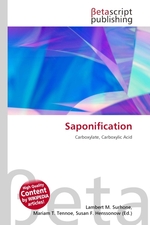Saponification
Lambert M. Surhone, Miriam T. Timpledon, Susan F. Marseken
бумажная книга
High Quality Content by WIKIPEDIA articles! Saponification is the hydrolysis of an ester under basic conditions to form an alcohol and the salt of a carboxylic acid (carboxylates). Saponification is commonly used to refer to the reaction of a metallic alkali (base) with a fat or oil to form soap. Saponifiable substances are those that can be converted into soap. Sodium hydroxide (NaOH) is a caustic base. If NaOH is used a hard soap is formed, whereas when potassium hydroxide (KOH) is used, a soft soap is formed. Vegetable oils and animal fats are fatty esters in the form of triglycerides. The alkali breaks the ester bond and releases the fatty acid salt and glycerol. If necessary, soaps may be precipitated by salting it out with saturated sodium chloride. The saponification value is the amount of base required to saponify a fat sample.
Данное издание не является оригинальным. Книга печатается по технологии принт-он-деманд после получения заказа.


